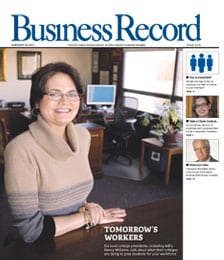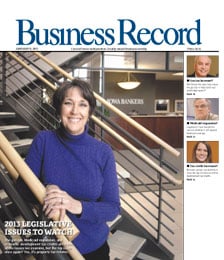Corporate airplanes a convenience-added travel option

Greater Des Moines corporations, like thousands nationally, invest millions of dollars in private air travel, citing the convenience of flying wherever, whenever, as well as the added comfort of flying with eight familiar faces. And it’s more than just high-powered executives flying in these airborne offices.
“Successful companies, the most successful and the best performing, tend to be companies that operate corporate airplanes,” said Don Jay, general manager of Elliott Aviation’s Des Moines operations.
Hy-Vee Inc., MidAmerican Energy Holdings Co., Townsend Engineering Co., FBL Financial Group Inc., Casey’s General Stores Inc., Meredith Corp., Principal Financial Group Inc., Pioneer Hi-Bred International Inc., Wellmark Blue Cross and Blue Shield of Iowa and several other companies all own jets or turbo-prop airplanes based at Des Moines International Airport or Ankeny Regional Airport. Some corporations have jets based elsewhere in Central Iowa. Maytag Corp. houses its jet at Newton Municipal Airport and Adel-based Stine Seed Co. has a jet based at the Perry Municipal Airport.
Townsend’s chief pilot, Bill Wagner, refers to these private owned aircraft as “time machines” that make corporate travel far more economical than commercial flights for getting company employees from points A to B.
Globetrotters
Company employees board flights for trips within Iowa or to countries such as Holland or the Philippines, visiting other company offices, customers or manufacturing sites, among other excursions.
Townsend Engineering’s multimillion-dollar 1999 Cessna Citation X allows for travel to all corners of the globe, and with a Rolls-Royce engine that can propel the plane to speeds reaching 600 mph at 50,000 feet, Chief Pilot Bill Wagner can get his passengers to European destinations in less than eight hours.
Townsend, which makes food-processing equipment, adds stickers of national flags to the Citation’s door upon visiting a new country. It added its 20th sticker recently when it made a stop in Spain. A smaller Piper airplane transports employees to locations within four or five states.
MidAmerican has operations in 28 U.S. states as well as the United Kingdom, Poland, the Philippines and Australia. The company’s corporate jet, a Falcon 50, provides convenience in those long-haul business trips that commercial airlines cannot provide.
“When you’re looking at flying to the Philippines, that’s going to have fewer stops than flying commercially,” said MidAmerican spokesman Allan Urlis.
At companies such as Townsend, private corporate travel is not restricted to company executives. Wagner said passengers on the Citation include everyone from owner Ted Townsend to factory employees and “they’re always VIPs”
“We pray for opportunities to fly those people,” he said. “There are no limitations on who can fly and that’s one of the myths. It’s the trip, the priority of the trip that really counts.”
Wagner said the Townsend airplane is an ideal means of working with clients who feel honored to be traveling on the jet. Initially, the company was concerned that “people would think we were fat cats.” Instead, he said, customers see the jet as a sign of Townsend’s financial stability.
“For some corporations, customer transportation is the single biggest reason for having corporate airplanes,” Jay said.
Once on board, employees find themselves not only in an intimate setting to conduct business deals with customers, Wagner said, but also a mobile office that allows them to keep in touch with corporate headquarters while in transit.
Jets built today include such amenities as telephone, Internet and fax connections, as well as entertainment options. The Townsend jet comes equipped with several small-screen televisions, and a large collection of DVDs are kept on board.
“A business airplane anymore is a lot more like [a management information system] than a corporate barge,” Jay said. “It’s simply a business tool and they regard it as such.”
Some jets, such as Townsend’s Citation, include seats that fully recline to allow passengers to sleep during a long flight, particularly to overseas destinations.
“Our company expects people to get off the airplane and work,” said Wagner.
Stress-free travel
Private travel, companies say, is all about conveniently transporting people anywhere in a hurry.
Smaller jets, unlike big commercial airliners, are not restricted to large regional airports. A jet flying to north central Georgia, for example, does not necessarily have to land at Hartsfield-Jackson Atlanta International Airport. Instead, it can use a smaller airport closer to the passengers’ final destination.
“Obviously the schedule is at your convenience and there is no need to go through a hub to go to wherever you really want to go,” Jay said. Also, for the most part, companies can set departure and arrival times that best suit their schedules.
Hy-Vee, which owns two jets and one twin-engine airplane, discovered the benefits of flying privately rather than commercially decades ago when the West Des Moines-based company began expanding its operations throughout the Midwest.
“Hy-Vee has had planes since the first corporate plane in the late 1960s when our territory became large enough that it was difficult to cover by car in a day,” said Ruth Mitchell, assistant vice president of communications.
With supermarkets in hard to reach locations such as Watertown, S.D., and the Ozarks in southern Missouri, Hy-Vee can use its planes to transport employees to several meetings in the region all in one day, often visiting Hy-Vee stores and potential locations for future stores.
“The way our company operates, our stores are very autonomous, but as a corporate office we stay very close to the operations,” Mitchell said. “Having the planes available enables our officers to cover more ground in a day and visit more locations.”
With four pilots who work exclusively for Hy-Vee, the company’s three airplanes are used almost daily. And those airplanes are also able to land in smaller towns such as Yankton, S.D., or Norfolk, Neb., destinations that, if flying commercially, would require hours of additional travel time in a motor vehicle once the airplane had landed.
With offices in 15 states in the Midwest and West, West Des Moines-based FBL Financial Group Inc. has seen the benefits of private corporate travel “from a cost and efficiency standpoint,” according to Kathleen Till Stange, director of investor relations.
“Our employees are able to put something into a one-day trip that would otherwise take a few days, so they can spend their evenings with their families as opposed to waiting in an airport,” said Till Stange.
For example, a trip made last week to New York City was completed in one day. Had the employees involved take commercial flights, the company would have incurred additional expenses.
“We would have the additional expense of stay at a hotel in the city, as well as the expense of not being at home,” Till Stange said.
She said travel on the company’s 1999 Beechjet 400A is available to all employees, based on the need and whether the cost is justified.
The 9/11 effect
Despite the lack of X-ray machines and metal detectors, Jay and Wagner both insist private corporate travel is safe and secure, and passengers take comfort in the fact that the eight passengers and two pilots on board are familiar faces within the company.
Yet the hijackings of four commercial airliners in the Sept. 11, 2001, terrorist attacks did not provide the boost to private air travel that Jay anticipated.
“What I saw was some companies tended to be busier with their corporate airplanes,” he said. “There were some additional planes that were bought, but I don’t think you could make the correlation that would related to the 9/11 events at all. And that was surprising. I expected there to be greater growth and there wasn’t.”
Wagner said he has observed private travel pick up approximately 10 to 12 percent since the Sept. 11 terrorist attacks because people feel more secure in those airplanes. And companies say private travel is far less stressful without long lines at security checkpoints.
Though there has not been a surge in company jet purchases, the industry has seen an increase in fractional ownership – several companies buying stakes in a group of airplanes. Elliott Aviation has seen a considerable amount of travel from those programs.
“There may be more companies involved with corporate planes, but not more corporate planes,” said Des Moines International Airport spokesman Roy Criss. “Most smaller companies wouldn’t need a $10 million jet to use every day, but if they need one maybe three times a month it would make sense to [participate in a fractional ownership program].”
Steady growth
Honeywell Aerospace’s 13th annual Business Aviation Outlook released last month reported manufacturer backlogs of nearly 1,500 aircraft orders, options and deposits, about 40 percent of which it attributed to fractional ownership programs.
The New Jersey-based company said that, after hitting a record in 2001, deliveries of private aircraft declined more than 30 percent over the next two years and reached bottom in 2003, which it attributed to uncertainties leading up to the war in Iraq. Over the next four years, however, Honeywell expects customers to purchase more than 8,300 jets valued at more than $131 billion.
“The past three years have been a testament to the resiliency of the business aviation industry,” said Honeywell President and CEO Bob Johnson in a press release.
According to Jay’s observations, the industry has followed a growth pattern similar to the U.S. economy – slow but steady.
“I would say it stabilized a little bit before 9/11 and stayed stable afterward, again, consistent with the economy,” he said.
After 27 years as chief pilot for Townsend Engineering, Bill Wagner has seen the ups and downs of the industry and the company he serves. He sees his role with at Townsend as more than a body in the cockpit. “With corporate aviation, we have so much to be proud of in our industry,” he said. “We don’t have to be locked up in the cockpit. We are part of a team that moves the company forward.”






